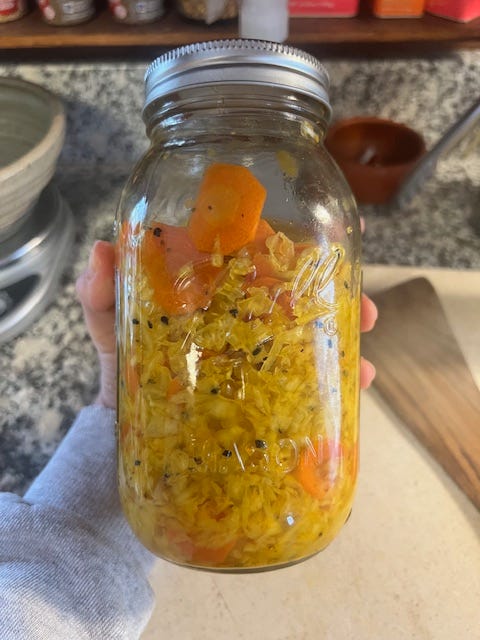Fermenting to Revere Cycles and Nourishing Our Microbiome
Taking no prisoners with my hyper-fixations
Humans have been fermenting food since forever. It is with this alchemy that both feasts and surviving famine have been possible for centuries. Grains, fruit, fish, legumes–these foods or “substrates” were transformed into long term staples across cultures, we know this by virtue of DNA remains collected from artifacts like mortar and pestles and pottery.
Commercial fermentation has obviously taken hold but what has survived for the majority of our time on this earth has been small-scale, spontaneous starters via “back-slopping”.1 This is what I am doing when I insist a friend take some starter and make their own bread. This discard; it is taking a bit of successfully fermented sourdough starter and feeding this new/old batch of bacteria. These microbes are resilient, responsive, I have become attached to them! As the bacteria feeds on the flour and water fed to it, carbon dioxide is released. This carbon dioxide is the key to the fermentation process and is the culprit of the magic—it is what allows our bread to rise, Astrid and myself chanting rise rise rise to our dough as if they were our very own weekly Frankensteins.
I was talking to yet another person about making bread yesterday and she was like “whoa, you really light up talking about bread” (lol) and it’s true. It has a grounding effect for me–working with my hands is an earthly pleasure I have always gravitated to. I feel as though I am flexing some ancient muscle, activating a conduit to past lives however murky those lives remain. I love the preparation and production through winter especially; we are making due, we are using what we have, it is a vessel for brighter glimpses of past seasons, our tomatoes, our berries preserved as jams. It is our little afternoon pick-me-up with butter and pear-cardamom preserve we were given for Christmas.
My starters and loaves are my community offering, and they are an offering to myself. Is it sometimes daunting to make bread when my daughter is a certified bread hound and needs it for her school lunches? A little. It also forces me to slow down with whatever plans I have and be present in my own body. I pour a cup of tea and take five to ten minutes for whatever step I am in with the process. I become present in my mind and body and that is damn hard to find these days. I become manically high and up my own ass whenever I pull a beautiful golden loaf out of the oven, I feel powerful and capable every single time.
Kraut and sourdough are integral to my meals on a daily basis and I stand by tried and true habits that support my health and immune system as someone with POI. With declining estrogen we are prone to inflammation. Actually, inflammation plays a role in aging across the board regardless of estrogen, however we see without estrogen’s protective qualities peri and postmenopausal persons are especially prone to inflammation. This can be seen in labs associated with our liver function like cholesterol, and the liver enzymes themselves, both elevating in perimeno and beyond. Our joints ache, “frozen shoulder” being a common tell-tale sign of peri/meno for many. Insulin resistance develops once our estrogen levels become erratic, eventually declining; this process promotes inflammation in the fat tissues that tend to collect in the torso and stay there.
Personally, my gut became sensitive and sluggish as a symptom of perimenopause and even with hormone therapy it functions best with a high fiber, whole foods approach. Being able to fortify my gut with fermented foods is crucial and something I like to discuss with menopause clients because it comes from a place of addition, not subtraction. I don’t believe restricting, especially when you are beginning to pay attention to your health, is helpful. What can we add to your current eating habits while you gather your bearings in this initial phase of curiosity? Let’s not burn out while you are motivated to make changes, but also feeling crappy.
A Stanford study in 2021, albeit small, found that incorporating fermented foods for ten weeks resulted in a decrease of inflammatory markers, one of which is associated with chronic stress and rheumatoid arthritis–disease pathways that are intrinsically tied to inflammation. The key-word in this study is that it was a short-term turnaround for results when eating fermented foods. The subjects were randomly assigned to either a high fiber or a fermented-foods diet for ten weeks. While the high fiber group did not see the same results as the fermented-foods group it may be that it takes a longer period of time for high-fiber diets to have an impact similar to fermented foods. Interestingly, the group consuming high fiber showed that their microbiomes still had a harder time breaking down the fibrous foods at the end of the ten-week trial. The microbiome takes time to shift and is reliant on what we put into it. All of this is to say, I really love my ferments, and I am glad they were too expensive to justify because they taste that much better now that I am making them. I will be giving yet ANOTHER person sourdough starter this week and helping them make their own bread. It’s a small thing, but it makes me happy sharing in this very human task.

I traded a perimenopause session for a tarot reading this past weekend (hellooooo Asheville) and the overarching card for my next six months can be seen below. I’m joining our tool library in hopes to help revamp their seed library and am getting my local library card today—it hasn’t changed a bit since I lived here twenty years ago which delights me to no end. I’m embracing cheesy and trying to find the shimmerrrrrrr.
Mannaa, M., Han, G., Seo, Y. S., & Park, I. (2021). Evolution of Food Fermentation Processes and the Use of Multi-Omics in Deciphering the Roles of the Microbiota. Foods (Basel, Switzerland), 10(11), 2861. https://doi.org/10.3390/foods10112861





